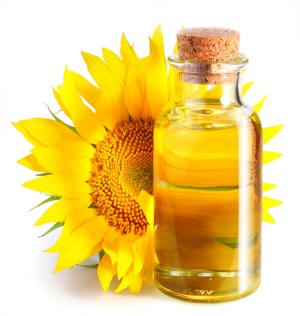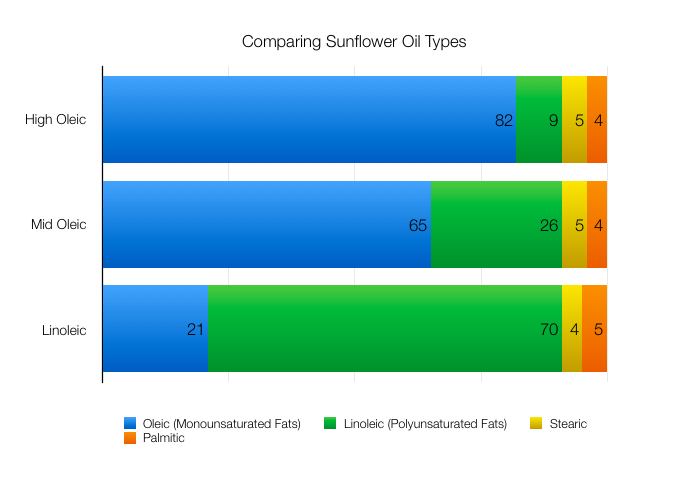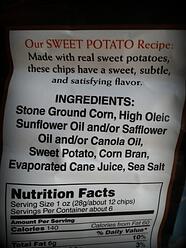
Sunflower and safflower oil are both extremely popular in the natural food industry right now. As brands look for healthier options (and move away from conventional GMO oils like soybean, corn, cottonseed and canola) sunflower and safflower become the next logical choice that many brands opt for.
Sometimes we see products that use one of these oils, and other times we see products that use BOTH interchangeably with an "and/or" statement on their ingredient list. If you had to choose between them, which is a better fit for you?
Today, we will take a closer look at these two oils to discuss how they are similar and how they are different. Of course, if you can use both, then do it! Both are good quality, naturally non-GMO oils perfect for use in snack foods, breads and frozen products. However, if you'd rather choose only one oil, let's dive into some information on each to help you decide.
Sunflower oil
This oil comes in three common varieties: high oleic, mid oleic, and linoleic. These terms refer to the balance between the different types fat that make up the oil.
High oleic oils are considered to be the most healthy and contain the most monounsaturated fat. Linoleic is comprised of more polyunsaturated fats and mid oleic falls somewhere in between.

Linoleic Sunflower Oil (Classic Sunflower Oil)
One of the essential fatty acids in a human diet is linoleic acid, which is another term for polyunsaturated fats. Though it may not be considered to be as healthy as oleic acid (monounsaturated fat), it is still a necessary component of our diet in small amounts. Linoleic Sunflower Oil has nearly 70% polyunsaturated fat. The other percentages are 20% monounsaturated fat or oleic acid, and the remaining 10% is saturated fat.
You will find that this is the cheapest type of sunflower oil on the market. It may be referred to as classic sunflower oil, it is most often a solvent extracted oil.
High Oleic Sunflower Oil
This oil is radically different in how it's made up, in comparison to linoleic sunflower oil. It is primarily comprised of monounsaturated oleic acids, at around 80% of the total. Saturated fat and polyunsaturated fat make-up the balance in equal proportions.
Bulk high oleic sunflower oil is important in the manufacturing of food products. The reason is because it's highly stable and will not go rancid in long-term storage. This makes switching your linoleic sunflower to high oleic sunflower an easy way for manufacturers to increase not only the make-up of healthy fats, but also the shelf life.
Due to being the highest quality, it's also the most expensive type of sunflower oil. It is available as an expeller pressed or solvent expelled oil, so make sure you get the type you are looking for. Most natural brands use the expeller pressed version.

Mid Oleic Sunflower
This oil takes a middle position between the two traditional oils mentioned above. This oil has monounsaturated fat accounting for roughly two-thirds of the fat content, polyunsaturated fat at roughly 25% and about 9% saturated fat.
Mid oleic sunflower oil retains the higher levels of linoleic acid that allow it to remain an excellent dietary source. However the relatively high level of oleic acid makes it less prone to breaking down and rancidity.
This oil used to be priced at a mid-range between the two above, but pricing is now closer to the high oleic costs. As many more brands swap to high oleic oils, farmers are moving more and more to growing high oleic seeds, making the mid-oleic less available.
Safflower Oil
Majority of the safflower oil available today is high oleic safflower oil. This has a similar lipid make-up to the high oleic sunflower oil that was described above.
If you are looking for high linoleic variety of safflower oil it is possible to get; however, it is typically grown in smaller volumes here in the US and is rarely used in the food industry. This oil is slightly more common in body care and pharmaceuticals.
Similarities between Sunflower and Safflower oil
These oils are similar in both their fat make-up, characteristics, and how they function in a product. These oils are similar enough that they are often approved by R&D teams to be used interchangeably in a recipe. To see this in action look at the back of natural chip brands: you'll often see "high oleic expeller pressed sunflower and/or safflower oil" listed as an ingredient.
Below we've listed their similarities in more detail:
Light color
Both oils are a very light yellow color. They are both refined so they don't contain very much color like an extra virgin olive oil would. This refining also makes the color consistent over time between many different lots.
Mild flavor
Both oils are very mild in flavor due to being refined, which removes much of the flavor during the high heat process. Because of this, both oils will not impart much of their own flavor into your product.
Price Point
When it comes to the price for these two oils, they are very similar (when comparing high oleic sun vs. high oleic saff). Not only are these oils used interchangeably, but they are produced almost identically. Over the years, sometimes the cost of sunflower will be less, and then the next year safflower will be less.
The supply and availability (and therefore the pricing) of these two oils is highly intertwined -- when availability of one goes down, many brands use the other. However, because sunflower is usually in slightly higher supply, this oil leans towards being slightly lower priced.
The differences between sunflower and safflower
Almost everything we have talked about so far is about how these oils are very similar in some key ways. However, they also have their differences that we will review. In comparison to their similarities, these differences are very slight -- not major at all.

Different Plant
Sunflower oil is produced from the sunflower plant. Yes, this is the flower you grow in your garden or put in a vase. The seeds at the center of the sunflower are what is collected and pressed to make the oil.
Safflower oil comes from a safflower plant. This plant grows in dry terrains and has a tall stalk with a bright prickly flower. The flower has bulbs below it that are seeds, which is what the oil is produced from.
Varieties of Sunflower
By now you have figured out there are multiple varieties of sunflower oil. The three most common are high oleic, mid oleic, and linoleic. The high oleic is common in the natural food industry, and the linoleic variety is produced in much larger volumes around the world. Classic sunflower (also known as linoleic) is actually quite common in low cost retail bottles sold globally.

Price Points of sunflower vs safflower
Above we mentioned that the price points were very similar for sunflower vs. safflower -- but remember, this only applied to the high oleic versions for each. Sunflower oil also has large volumes of the cheap linoleic variety produced which is much lower cost than the high oleic versions of either sunflower or safflower.
Supply of sunflower oil
Sunflower is a much more globally developed oil. This means that there is much more of it produced in different locations around the world. It has also been a popular choice for much longer. If you are looking for extremely high volumes, sunflower is going to be the best option for you.
Organic Varieties
The most common organic versions of these oils are Organic High Oleic Safflower Oil and Organic High Oleic Sunflower Oil. The reason that most organic varieties are also high oleic is because the same people/products looking for organic varieties are also looking for the healthiest type of oil: which is high oleic.
There are also organic versions of mid oleic and linoleic sunflower oil. However, they are much less commonly available.
Trends & Comparisons
Safflower is popular in foodservice and the PNW
Safflower oil has been particularly popular in the foodservice realm. Part of this is due to it's high smoke point. It is also great as an ingredient in prepared foods and cooking alike. This region preference is a bit unexplained but is definitely something we have seen.
Sunflower oil: Popular in Manufacturing
Sunflower oil has been particularly popular in food manufacturing industry because it is available in large volumes, has different fat makeups and correspondingly has different price points available too.

Manufacturers are choosing both
When it comes to manufacturing, food companies are often opting to leave their options open to include both safflower and sunflower oil on their ingredient labels. This allows them to keep as open of a supply chain as possible, protecting themselves from risk of blight, supply issues and price fluctuations.
Topics: Food Manufacturing, Sunflower/Safflower Oil, Purchasing & Procurement












